
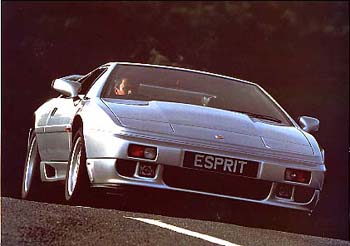
Esprit joins the 'user friendly'
brigade
In response to customer complaints, Lotus has
revamped the Esprit
to improve cabin space and rearward visibility.
ONE OF THE POTENTIAL advantages of being a low-volume car maker is that you know who your customers are. And if they don't like something, they tell you about it. Lotus knows this because its customers had plenty to say about Britain's only mid-engined supercar, the Esprit.
They complained that they had difficulty getting in and out because the doors didn't open wide enough, and that the shortage of headroom militated against finding a comfortable driving position. With such a mean rear window and a tail spoiler plonked bang in the line of vision, they couldn't see out the back, either. Some even complained that the car understeered too much at speed.
Lotus listened, of course, but no one would have thought any the worse of the company if it hadn't reacted. After all, mid-engined supercars aren't contractually obliged to be practical and the Esprit was by no means as uninhabitable as some. Old-school doctrine on the subject stubbornly suggests that at no cost should supercars be 'easy'.
Exotics such as the Lamborghini Countach championed this cause by being so uncomfortable, hard to see out of, noisy and tiring to drive that the sense of achievement to be had from moving the car between A and B was surpassed only by the relief at getting out.
But attitudes are changing. Even Porsche — maker of the sports car with the most unfathomable control layout in the world, the 911 — realised that a few morsels of user-friendliness wouldn't go amiss in the Carrera 2, while the Countach's successor, the Diablo, is virtually a reformed character. And when Lamborghini starts to make an ergonomically convincing car, it's time to send the old nonsense about ''conquering the car to achieve a deeper level of understanding and satisfaction'' back to the heartland of macho inadequacy from whence it sprang.
The clever thing about Lotus's revisions to the 264bhp, 165mph, £48,260 Esprit SE is that, on the outside at least, they look like fanciful, free-wheeling injections of stylistic drama, administered to 'juice up' the Esprit's image with scant regard for anything other than acquiring the aesthetic clout to upstage passing Ferraris.
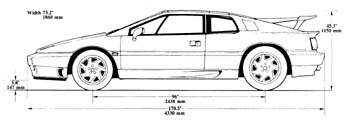
From whichever angle you approach it, there is nothing subtle about the new rear spoiler. It makes that which adorned the rump of the original Sierra Cosworth look like an extra coat of paint. The important thing, however, is that it's high enough to clear the new, glassless 'open back' tailgate with its extravagantly louvred engine cover. Now there's just a vertical pane of glass between the rear-view mirror and the outside world. Rearward visibility has been improved by several hundred per cent — albeit from a level where it barely existed at all.
Lotus designer and aerodynamicist Richard Hill claims there's more to the massive wing than a better view: ''Removal of the glassback and raising the rear wing was necessary to obtain unobstructed rear mirror vision. In doing this, the longitudinal position and wing attitude have been set to maximise stability with the minimum drag penalty. This has been complemented by the addition of a rubber front lip spoiler, which allows a neutral lift performance to be achieved. The upshot is less lift at the front and, therefore, a reduced tendency to understeer and an improvement in top speed from 163 to 165mph.''
''The design of the tailgate has also been carefully developed to ensure maximum engine bay airflow for cooling It provides a 'zoned' airflow pattern which prevents hot air from the turbo and exhaust manifold heating up other sensitive components.''
Less obvious but even more extensive is the repackaging of the cabin. The bottom line is an additional 5.6ins of headroom, 1.6ins more legroom and up to 3.2ins more clearance between seat and steering wheel. A new rear bulkhead extends the cabin length by 1.2ins and a new pedal box with revised geometry gives shorter pedal actions. By making the centre tunnel narrower, Lotus has been able to make the seats wider for the benefit of broader beams. Long torsos get a better deal, too, a removable cushion in the squab effectively liberating more headroom by lowering the seating position.
Many would say that, in relation to the road surface, the seating position was pretty low already. But getting in and out has been made easier by doors that open 15 deg wider — that's 9ins measured at the back of the door. It's one of those things you wouldn't necessarily notice unless someone told you. The improvements don't register straight away; instead, there's a slow realisation that you're not being driven mad by the old problems. Having an unimpeded view straight back is the best news of all, but not having your hairstyle compressed by the roof lining is almost as good. As promised, the pedals feel firmer and more positive and the reshaped seats are certainly comfortable and supportive, but for my amply padded 5ft 8ins frame the driving position still isn't quite right, the steering wheel being a bit of a stretch with the seat set correctly for the pedals.
On Millbrook's tortuous handling circuit, it was impossible to determine whether the new SE understeered less than its predecessor, as claimed by Lotus, but it still understeered too much in the tighter turns, making it hard to apply the prodigious power of the charge-cooled 2.2-litre four early enough out of corners.
The point about the Esprit SE is that it has so much performance, you seldom need to press hard. The styling changes promise an excitement that, during my time with the car, I never really found. That doesn't stop it from being a better car than before, or more desirable. Never mind the understeer, feel the thrust.
Road test: 1992
LOTUS'S LAST STAND?

Lotus's sole surviving model, the Esprit, still has
what it takes
to crush newer rivals from Renault and MVS.
Wales was like a film set clear blue skies, a mellow warmth in the air and sunshine glinting off the sharply raked windscreens of the trio of broad-shouldered supercars. Back at Hethel, home of Lotus, the future looked anything but bright. Unknown to us at the time, a storm was brewing that would make the outcome of our battle of the plastic powerhouses even more poignant.
The Excel may have died of old age, but the Elan was cut down in its prime, leaving Lotus with just the Esprit. We put the 16-year-old car up against Renault's revamped A6 10 and the little-known but highly respected MVS venturi 260 to determine who makes the best cut-price suitor to the court of Ferrari.
If looking, good and going fast were all that mattered, each of our plastic supercars could be an unqualified sales success. But prestige and price share equal billing, and if their combined British sales top 100 this year their makers will count themselves lucky.
Of the three, it's obvious which one comes from a mainstream manufacturer. Not only is the Alpine much cheaper — £37,980 against £47,790 for the Lotus and £47,979 for the MVS — but it's also roomier, boasting an extra pair of seats in the back, and has damn near as much beef in its boot: 250bhp to the Venturi's 260bhp and the Esprit's 264bhp.
Day one was to be a scratch-it-and-see exercise, a time for acclimatisation and forming initial opinions. With mid and rear-engined cars such as these, driving fast without comprehensively researching your subject first is asking for trouble.
The Renault, to no one's great surprise, had walked the opening rounds on the motorway, its superior refinement and fine all-round visibility putting to shame the Esprit's buzzy engine note and the venturi's peculiar inability to cruise smoothly at a constant speed. The A6 10 was scoring well in the looks-per-mile game, too, closely followed by the outrageously bewinged Esprit. Fewer people seemed to be interested in the pretty but less boisterous-looking MVS.


By the end of that first day, road test editor Frankel and I were all but convinced the A610 was best, less effort to drive quickly, more economical (about 20mpg compared with 18mpg for the Lotus and 17mpg for the Venturi) and seemingly every bit as fast, its ease seemed bullet-proof. The Esprit, having spent the '80s doing battle with Ferrari 308s and often as not winning, looked like it was going to be knocked clean out of the ring by a Renault. It reminded us of Ali being flattened by Larry Holmes.
Day two. Sliding down into the Esprit's cabin again, the driving position and controls don't seem as ridiculous as they did yesterday. It's still impossible to see the fuel gauge through the steering wheel, the minor switch location is a joke and the seat offers about as much under-thigh support as a stand-up French toilette. But it's better than any previous esprit. Tall drivers, like the 6ft 4ins Frankel, can now cover long distances in discomfort rather than numb agony, thanks to fractionally increased legroom, while the new tail-mounted surfboard now hints at allowing some rear vision.
It's still nothing like as coherent as the Renault's tidy but ultimately plain cabin, which sports the best driving position of the lot, even if the floor-hinged pedals still seem to try to be different for the sake of it. Nor is it a match for the hand-crafted, Connally-clad (£1243 extra) MVS cockpit, which is so much classier that it makes the other two feel like a Ford Escort inside.
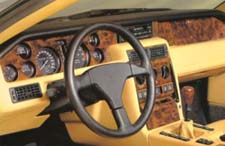

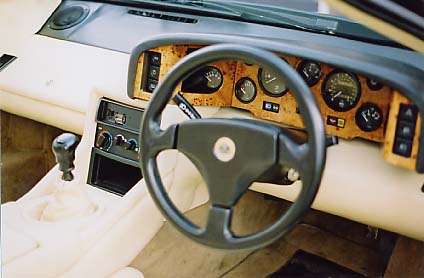
I lead out of the car park in the MVS, gradually getting back in tune with the 2.8-litre pushrod V6 turbo's split personality. It may be essentially the same engine that powers the Renault, but MVS's modifications have turned it from an honest, hard worker into a fire-breathing powerhouse with well over 3001b ft of torque itching to let rip as proof. At 2000rpm the turbo bids me good morning, with a sound like a salvo of pea-shooters, and the Venturi lunges forward. So hard and so fast, in fact, that the other two are momentarily engulfed in a plume of dust, unable to match the MVS's hyperspace mid-range punch and immediacy of pick-up.
Eventually I lift off and allow the others to reel me in, but the Venturi has already made its point. For sheer 'squirtability' it has no rival here, tearing between 50-70mph in top in just 5.8secs, a full second inside the A6 10 and well over half a second in front of the Lotus. That's quick enough to leave anything this side of a Diablo in the gutter.
After the Venturi, the A6 10 seems almost sensible, and therein lies its problem. Genuinely rapid car though it is, the Alpine doesn't feel all that quick, not in the same all-or-nothing manner as the MVS. In truth it isn't as fast, but the real reason it appears so much less dramatic — less of a supercar, if you like — is the three-litre V6 turbo engine's smooth, quiet and even operation. Commendable traits under more ordinary circumstances, they act as a spoiler to the raw thrills factor that makes its rivals seem so special.
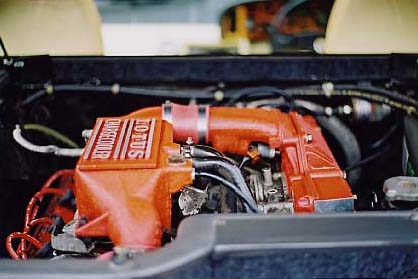

The Lotus takes longer to answer the call of your right foot, but when it does you'd better believe it can deliver a wallop that's stronger than all of them. And any difficulty you might have understanding just how quick it is can be laid to rest by the mind-tingling 4.7secs 0-60mph time we clocked — over a second up on the A610 and half a second quicker than the blistering Venturi. It doesn't run out of steam until the 7400rpm limiter pulls stumps, feeling more the genuine thoroughbred than either of the two French cars, even if its twin-cam 2.2-litre 16-valve engine is the worst sounding of the lot.
There are deeper problems than this with the Esprit, though. All three share the same Renault gearbox, but the Esprit's feels looser and more rubbery than the others. And then there's the brakes. Fine under mild pressure, the Esprit's anchors aren't as solid as they should be under heavy use, suffering from big fade on occasions when neither the MVS nor A610 raised a sweat.
But the steering — once an Esprit bugbear — is now magic in the right conditions. Tiresomely heavy at low speeds, it suddenly comes alive when you point the car's shovel nose at a Welsh mountain, channelling messages from the tyres to your fingers like Kim Philby to the Kremlin. You need a much firmer grip on the rim than in the other two assisted arrangements, and it's harder work. But, given that this allows a more intimate involvement with the workings of - the chassis and, consequently, a richer driving experience, that's a price well worth paying.
That said, the Lotus simply doesn't have the front-end bite of the other two, and in spite of recent front suspension modifications it still understeers too much. Compared with the MVS, which appears to suffer no understeer at all and has the sort of traction out of slow corners that makes your hair stand up on end, the Esprit can seem quite a handful on really narrow roads. But at least it's on steadier ground next to the A6 10, whose chassis lacks the involvement of the Lotus and the grip, turn-in, balance and pure agility of the Venturi.
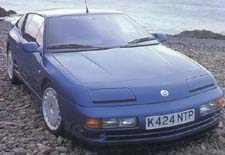
By the time we left Wales, our thoughts of 24 hours ago had been turned on their head. The MVS still split the two — a place earned because its cabin and knockout punch made it special, even if its strangely uncommunicative steering stopped it from feeling like a bona fide supercar. But on that second day the A610 let slip something we could never have guessed from our initial drive. In its quest for outright ability it had sold its soul and left us chilly — something its predecessor, the intimately involving GTA, would never have done.
The Esprit, on the other hand, has sold out to no one. Yes, it's technically inferior to both its French opponents, slower than the MVS cross-country and requires more effort than the A610 to drive at the same speed. But it's the only one that smacks at supercardom. In the Venturi or A610 you recall a 10-mile stretch of road with a smile, but that's about as far as it goes. In the Lotus you remember each camber change on every corner with a grin that threatens to split your face in two. Which makes it a more memorable car than the French pair.
The Esprit, says Lotus, is not dead, merely resting. Ask Lotus Engineering and they will even build you one to special order. And it's developing power steering, better brakes and further cabin revisions for next year. Let's hope the result continues to recognise that in cars like these it's not how fast you get there that matters most, it's how much fun you have on the way.
|
|